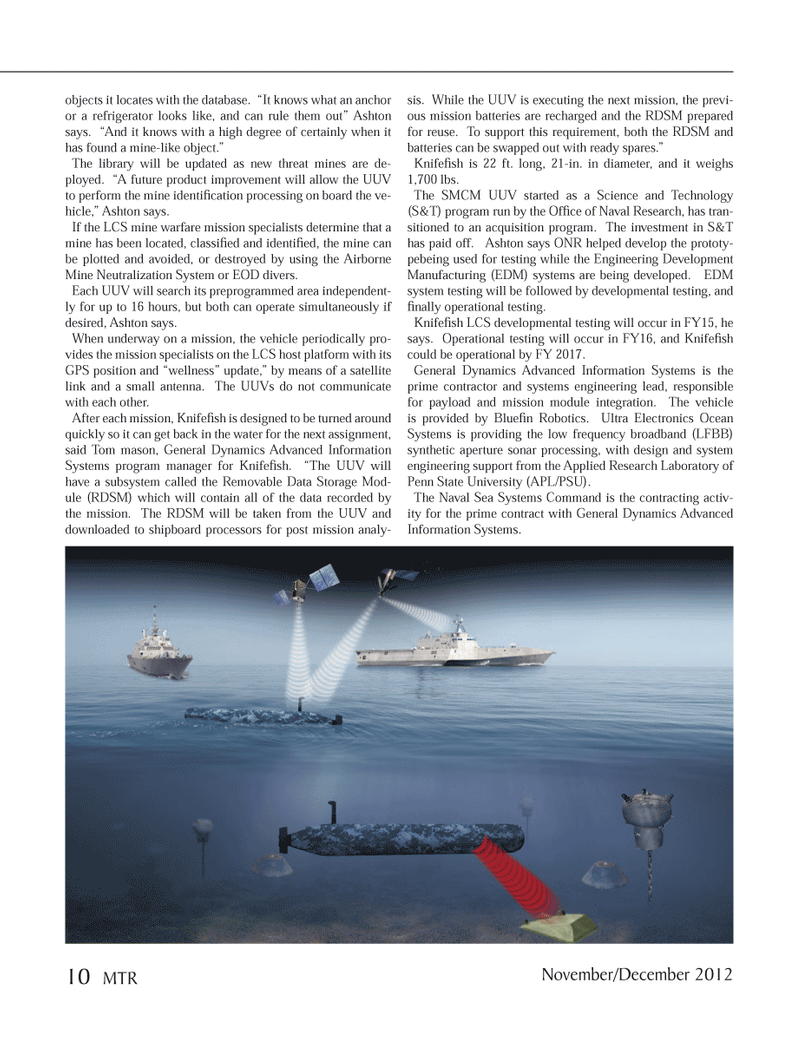
Page 10: of Marine Technology Magazine (November 2012)
Fresh Water Monitoring & Sensors
Read this page in Pdf, Flash or Html5 edition of November 2012 Marine Technology Magazine
objects it locates with the database. ?It knows what an anchor or a refrigerator looks like, and can rule them out? Ashton says. ?And it knows with a high degree of certainly when it has found a mine-like object.? The library will be updated as new threat mines are de- ployed. ?A future product improvement will allow the UUV to perform the mine identi cation processing on board the ve- hicle,? Ashton says. If the LCS mine warfare mission specialists determine that a mine has been located, classi ed and identi ed, the mine can be plotted and avoided, or destroyed by using the Airborne Mine Neutralization System or EOD divers. Each UUV will search its preprogrammed area independent-ly for up to 16 hours, but both can operate simultaneously if desired, Ashton says. When underway on a mission, the vehicle periodically pro- vides the mission specialists on the LCS host platform with its GPS position and ?wellness? update,? by means of a satellite link and a small antenna. The UUVs do not communicate with each other. After each mission, Knife sh is designed to be turned around quickly so it can get back in the water for the next assignment, said Tom mason, General Dynamics Advanced Information Systems program manager for Knife sh. ?The UUV will have a subsystem called the Removable Data Storage Mod- ule (RDSM) which will contain all of the data recorded by the mission. The RDSM will be taken from the UUV and downloaded to shipboard processors for post mission analy- sis. While the UUV is executing the next mission, the previ- ous mission batteries are recharged and the RDSM prepared for reuse. To support this requirement, both the RDSM and batteries can be swapped out with ready spares.? Knife sh is 22 ft. long, 21-in. in diameter, and it weighs 1,700 lbs.The SMCM UUV started as a Science and Technology (S&T) program run by the Of ce of Naval Research, has tran- sitioned to an acquisition program. The investment in S&T has paid off. Ashton says ONR helped develop the prototy- pebeing used for testing while the Engineering Development Manufacturing (EDM) systems are being developed. EDM system testing will be followed by developmental testing, and nally operational testing. Knife sh LCS developmental testing will occur in FY15, he says. Operational testing will occur in FY16, and Knife sh could be operational by FY 2017.General Dynamics Advanced Information Systems is the prime contractor and systems engineering lead, responsible for payload and mission module integration. The vehicle is provided by Blue n Robotics. Ultra Electronics Ocean Systems is providing the low frequency broadband (LFBB) synthetic aperture sonar processing, with design and system engineering support from the Applied Research Laboratory of Penn State University (APL/PSU). The Naval Sea Systems Command is the contracting activ- ity for the prime contract with General Dynamics Advanced Information Systems.November/December 201210 MTRMTR #9 (1-17).indd 10MTR #9 (1-17).indd 1012/3/2012 12:26:57 PM12/3/2012 12:26:57 PM

 9
9

 11
11
